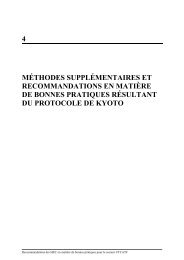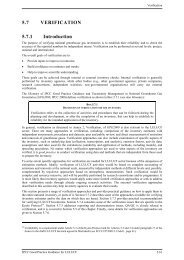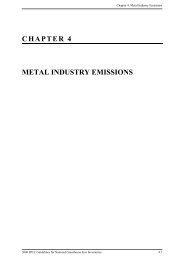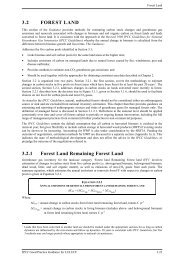Use of Models and Facility-Level Data in Greenhouse Gas Inventories
Use of Models and Facility-Level Data in Greenhouse Gas Inventories
Use of Models and Facility-Level Data in Greenhouse Gas Inventories
You also want an ePaper? Increase the reach of your titles
YUMPU automatically turns print PDFs into web optimized ePapers that Google loves.
<strong>Use</strong> <strong>of</strong> <strong>Models</strong> <strong>and</strong> <strong>Facility</strong>-<strong>Level</strong> <strong>Data</strong> <strong>in</strong> <strong>Greenhouse</strong> <strong>Gas</strong> <strong>Inventories</strong><br />
The required scope for data report<strong>in</strong>g under ETS is def<strong>in</strong>ed by the blue boxes <strong>in</strong> the top part <strong>of</strong> the figure, <strong>and</strong> <strong>in</strong>cludes<br />
fuel use <strong>and</strong> estimates <strong>of</strong> emissions from each site <strong>in</strong>cluded <strong>in</strong> the ETS. In the figure, the fuel uses (gas, oil <strong>and</strong> biomass<br />
combustion) from the two ETS sites (at the top <strong>of</strong> the figure) are reported <strong>in</strong> the UK national energy statistics (DUKES),<br />
<strong>and</strong> via the ETS returns. Fuel use from flar<strong>in</strong>g <strong>in</strong> chemical <strong>in</strong>dustry is not explicitly reported <strong>in</strong> DUKES, <strong>and</strong> historically<br />
has been estimated by the GHG <strong>in</strong>ventory team from data supplied directly by <strong>in</strong>dustry. This estimation is necessary<br />
because ref<strong>in</strong>ery <strong>of</strong>f-gases (OPG <strong>and</strong> other gases) are not well tracked <strong>in</strong> UK energy statistics. A key benefit <strong>of</strong> the ETS<br />
report<strong>in</strong>g <strong>in</strong> the UK is that fuel uses <strong>and</strong> emissions from flar<strong>in</strong>g are now directly available to the UK GHG <strong>in</strong>ventory, <strong>and</strong><br />
can be used to improve the accuracy <strong>of</strong> the estimates <strong>of</strong> the emissions from this sector.<br />
At the bottom <strong>of</strong> the figure, with a boundary demoted by a blue dotted l<strong>in</strong>e, is a small chemical site which is not covered<br />
under the ETS. Some <strong>of</strong> the fuel use from this site would be <strong>in</strong>cluded <strong>in</strong> the UK national energy statistics, but the flar<strong>in</strong>g<br />
would not. The omission <strong>of</strong> this site from the ETS highlights the po<strong>in</strong>t that the whole sector must report to the ETS<br />
before it is possible to consider replac<strong>in</strong>g emissions <strong>in</strong> the UK GHG with ETS data.<br />
Emission estimates <strong>in</strong> the GHG <strong>in</strong>ventory cover UK-wide sources such as the total emissions from coal combustion<br />
across all <strong>of</strong> the UK power stations, or emissions from all <strong>of</strong> the calc<strong>in</strong>ation <strong>of</strong> limestone <strong>in</strong> the UK’s cement kilns. The<br />
example <strong>of</strong> report<strong>in</strong>g by the iron <strong>and</strong> steel <strong>in</strong>dustry under the ETS <strong>and</strong> the problems <strong>of</strong> the us<strong>in</strong>g the ETS data <strong>in</strong> the<br />
GHG <strong>in</strong>ventory are shown <strong>in</strong> Figure 1-2.<br />
Figure 1-2<br />
<strong>in</strong>dustry<br />
<strong>Data</strong> report<strong>in</strong>g comparison <strong>of</strong> IPPC compared to GHG <strong>in</strong>ventory for part <strong>of</strong> the iron <strong>and</strong> steel<br />
IPCC estimate 1A1c<br />
(coke oven)<br />
IPCC estimate 1A2a<br />
(site power plant)<br />
IPCC estimate 2C1<br />
(process emission)<br />
EUETS estimate (1) Iron & Steel Site 1 coke oven energy conversion fuel combustion Process source: decarbonisation<br />
EUETS estimate (2) Iron & Steel Site 2 coke oven energy conversion fuel combustion Process source: decarbonisation<br />
EUETS estimate (3) Iron & Steel Site 3 coke oven energy conversion fuel combustion Process source: decarbonisation<br />
<strong>Data</strong> <strong>in</strong> the CITL are given by site or <strong>in</strong>stallation, <strong>and</strong> it may be difficult to identify emissions accord<strong>in</strong>g to the activity<br />
responsible, for example from combustion related emissions, or from process related emissions. In the example above,<br />
it would be difficult to separate the emissions from the fuel combustion <strong>in</strong> the coke ovens <strong>and</strong> site power plant (reported<br />
under 1A) from the process emissions reported under 2C1 <strong>in</strong> the ETS returns.<br />
In summary, the emissions data <strong>in</strong> the GHG <strong>in</strong>ventory groups together multiple sites (<strong>in</strong> this case all iron <strong>and</strong> steel<br />
plants), while the data <strong>in</strong> the CITL group together multiple emission sources (<strong>in</strong> this case combustion <strong>and</strong> process<br />
emissions).<br />
Some other UK datasets are a hybrid <strong>of</strong> these two extremes, where some level <strong>of</strong> detail is available for site-specific<br />
emissions by source type. Examples <strong>in</strong>clude:<br />
• EEMS. The UK's Environmental Emissions Monitor<strong>in</strong>g System; EEMS is the environmental database <strong>of</strong> the UK<br />
Oil <strong>and</strong> <strong>Gas</strong> <strong>in</strong>dustry. Oil <strong>and</strong> gas <strong>in</strong>stallations report to DECC, provid<strong>in</strong>g site-specific annual estimates that are<br />
broken down <strong>in</strong>to sources such as: gas combustion, oil combustion, process sources, fugitives, flar<strong>in</strong>g, vent<strong>in</strong>g,<br />
well test<strong>in</strong>g;<br />
• UK Petroleum Industry Association (UKPIA). Ref<strong>in</strong>ery data are provided to present emissions by <strong>in</strong>stallation,<br />
with separate figures for the combustion <strong>and</strong> process sources <strong>of</strong> the oil ref<strong>in</strong><strong>in</strong>g processes.<br />
• Corus. Iron <strong>and</strong> steel <strong>in</strong>tegrated steelworks data are provided that present a breakdown <strong>of</strong> IPPC emissions<br />
data across the different process units on site <strong>in</strong>clud<strong>in</strong>g: coke ovens, s<strong>in</strong>ter plant, BOS plant, stockpiles.<br />
Examples <strong>of</strong> the type <strong>of</strong> data that are available via the CITL (publically accessible), from detailed ETS returns by the<br />
operators (commercially confidential), <strong>and</strong> from the database <strong>of</strong> all emissions compiled by the UK Environment Agency,<br />
the UK ETS regulator, (commercially confidential) are given <strong>in</strong> Annex 1, Annex 2 <strong>and</strong> Annex 3.<br />
IPCC Expert Meet<strong>in</strong>g Report 73 TFI

















